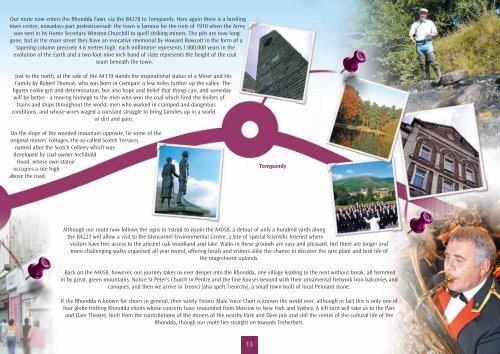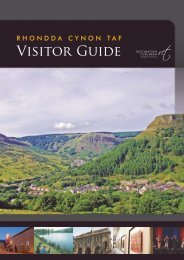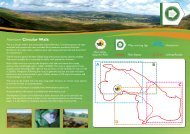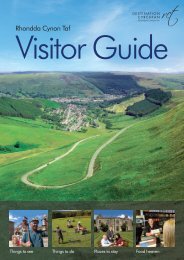talking point - Rhondda Cynon Taf
talking point - Rhondda Cynon Taf
talking point - Rhondda Cynon Taf
You also want an ePaper? Increase the reach of your titles
YUMPU automatically turns print PDFs into web optimized ePapers that Google loves.
Our route now enters the <strong>Rhondda</strong> Fawr, via the B4278 to Tonypandy. Here again there is a bustling<br />
town centre, nowadays part pedestrianised: the town is famous for the riots of 1910 when the Army<br />
was sent in by Home Secretary Winston Churchill to quell striking miners. The pits are now long<br />
gone, but in the main street they have an evocative memorial by Howard Bowcott in the form of a<br />
tapering column precisely 4.6 metres high: each millimetre represents 1,000,000 years in the<br />
evolution of the Earth and a two-foot-nine inch band of slate represents the height of the coal<br />
seam beneath the town.<br />
Just to the north, at the side of the A4119 stands the inspirational statue of a Miner and His<br />
Family by Robert Thomas, who was born in Cwmparc a few miles further up the valley. The<br />
figures evoke grit and determination, but also hope and belief that things can, and someday<br />
will be better - a moving homage to the men who won the coal which fired the boilers of<br />
trains and ships throughout the world, men who worked in cramped and dangerous<br />
conditions, and whose wives waged a constant struggle to bring families up in a world<br />
of dirt and pain.<br />
On the slope of the wooded mountain opposite, lie some of the<br />
original miners’ cottages, the so-called Scotch Terraces,<br />
named after the Scotch Colliery which was<br />
developed by coal-owner Archibald<br />
Hood, whose own statue<br />
occupies a site high<br />
above the road.<br />
Although our route now follows the signs to Ystrad to rejoin the A4058, a detour of only a hundred yards along<br />
the B4223 will allow a visit to the Glyncornel Environmental Centre, a Site of Special Scientific Interest where<br />
visitors have free access to the ancient oak woodland and lake. Walks in these grounds are easy and pleasant, but there are longer and<br />
more challenging walks organised all year round, offering locals and visitors alike the chance to discover the rare plant and bird life of<br />
the magnificent uplands.<br />
Back on the A4058, however, our journey takes us ever deeper into the <strong>Rhondda</strong>, one village leading to the next without break, all hemmed<br />
in by great, green mountains. Notice St Peter’s Church in Pentre and the fine houses beyond with their ornamental fretwork iron balconies and<br />
canopies, and then we arrive in Treorci (also spelt Treorchy), a small town built of local Pennant stone.<br />
If the <strong>Rhondda</strong> is known for choirs in general, then surely Treorci Male Voice Choir is known the world over, although in fact this is only one of<br />
four globe-trotting <strong>Rhondda</strong> choirs whose concerts have resounded from Moscow to New York and Sydney. A left turn will take us to the Parc<br />
and Dare Theatre, built from the contributions of the miners of the nearby Park and Dare pits and still the centre of the cultural life of the<br />
<strong>Rhondda</strong>, though our route lies straight on towards Treherbert.<br />
13<br />
Tonypandy





